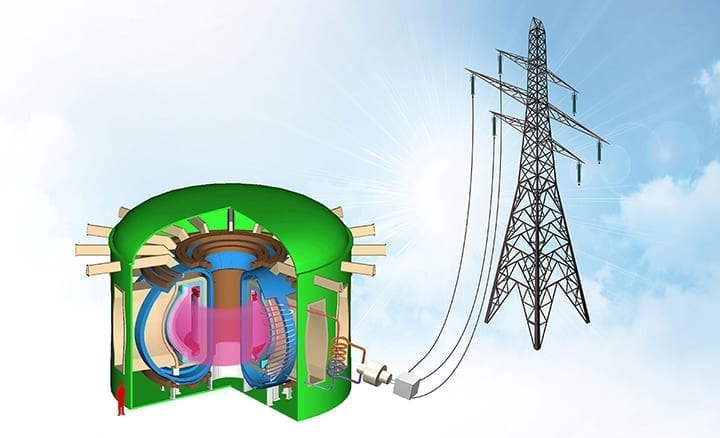The post Compact Advanced Tokomak Concept Takes Fusion Power One Step Closer to Commercial Reality appeared first on POWER Magazine.

Scientists at the DIII-D National Fusion Facility have released a new design for a compact fusion reactor that can generate electricity and help define the technology necessary for commercial fusion power.
General Atomics, which operates the DIII-D facility in San Diego, California, for the U.S. Department of Energy, says the approach is based on the “Advanced Tokamak” concept pioneered by the DIII-D program. The design is said to enable a higher-performance, self-sustaining configuration that holds energy more efficiently than in typical pulsed configurations, allowing it to be built at a reduced scale and cost.
“The key to our approach is to raise the pressure inside the tokamak,” Dr. Richard Buttery, director of experimental science for the DIII-D facility and leader of the project, said in a statement issued to POWER. “This makes more fusion occur, allowing us to reduce the current, which in turn makes the plasma easier to sustain and more stable. Our simulations show that by carefully shaping the plasma and moving the current toward its edge, we can suppress turbulent heat losses and support higher pressures at lower currents, to reach a state where the plasma sustains itself. This enables a device that can simply be turned on, generating electricity continuously in a steady state.”
As Buttery explained to POWER in a video interview last year, a tokomak is a powerful vacuum chamber that uses magnetic fields to hold very hot current-carrying gas, known as plasma, together in the shape of a donut. “When you get gases to very high temperatures, if you have the right ingredients, they will fuse—just like in the sun—and release energy,” he said.
Nuclear fusion occurs when light elements such as hydrogen are brought together at extremely high temperatures—over 100 million degrees—and pressures, causing the nuclei to fuse into heavier elements such as helium. This process powers stars like the sun and releases vast amounts of energy. Fusion power plants are expected to be fueled by a mixture of hydrogen isotopes: deuterium (the nucleus comprises a proton and a neutron) and tritium (the nucleus comprises a proton and two neutrons). Fusion differs from nuclear fission, where heavy elements are split into lighter elements, releasing energy, which is the process used in existing commercial nuclear power plants.
The recently announced Compact Advanced Tokamak (CAT) concept was described in an 18-page article published in the journal Nuclear Fusion. The design arose from first-of-a-kind reactor simulations that leverage the latest physics understanding of these plasmas to raise performance. General Atomics said the approach combines state-of-the-art theory it helped develop with leading-edge computing by Oak Ridge National Laboratory scientists using the Cori supercomputer at the National Energy Research Scientific Computing Center (NERSC), and is based on development and testing of the underlying physics concepts on DIII-D (Figure 1).

The DIII-D Program is a large international program, with 106 participating institutions and a research team of more than 600 users. The mission of the program is to establish the scientific basis for the optimization of the tokamak approach to fusion energy production. DIII-D is considered a cornerstone element in the U.S.’s national fusion program strategy.
“On the way to a fusion power plant, there are still a variety of design options to be considered,” Professor Hartmut Zohm, a leading scientist on fusion energy development with the Max-Planck-Institute of Plasma Physics in Germany, who was not involved in the CAT design. “The one presented here is an aggressive, optimistic approach, building on the work done at the DIII-D tokamak over the last two decades, and I think it adds an interesting perspective on the problem.”
General Atomics claims that because the CAT drives most of its own current during operation, this “reduces the need for expensive current-drive systems that consume generated power and reduce the plant’s efficiency.” The increased performance and energy containment of the CAT approach enables it to operate at lower plasma current than pulsed concepts. This, and continuous steady-state operation, reduce stress on the device and lower risks to machine integrity, making for a more robust, compact design with lower heat loads.
Work is now progressing to resolve control and heat management issues in steady-state plasmas. Meanwhile, technology programs are ramping up across the U.S. to develop the reactor materials, magnets, and other advanced techniques required for deployment of the first fusion pilot plant.
“These are exciting times for fusion energy,” Buttery said. “The United States now has a vision for a fusion pilot plant with design commencing soon. We have a good understanding of the work needed to get us there and many amazing tools we can deploy in this quest to bring limitless carbon-free energy to the planet.”
—Aaron Larson is POWER’s executive editor (@AaronL_Power, @POWERmagazine).
The post Compact Advanced Tokomak Concept Takes Fusion Power One Step Closer to Commercial Reality appeared first on POWER Magazine.